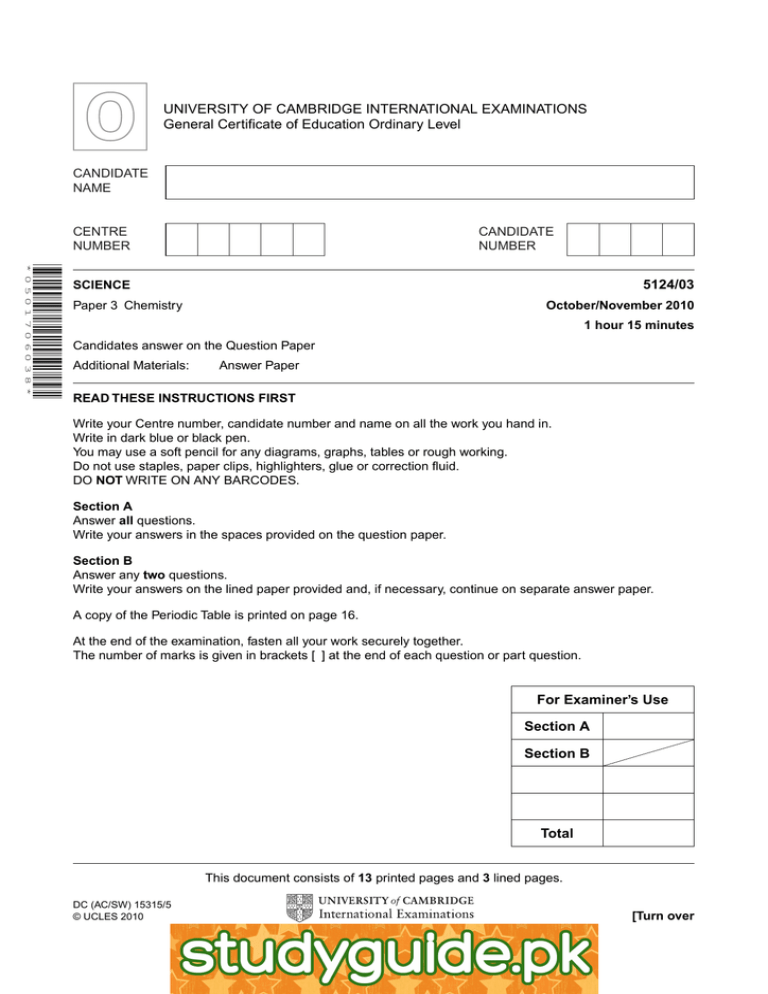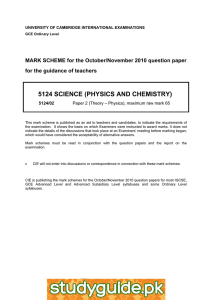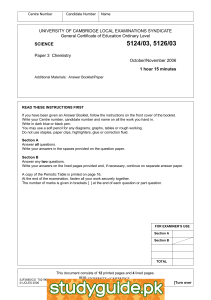UNIVERSITY OF CAMBRIDGE INTERNATIONAL EXAMINATIONS General Certificate of Education Ordinary Level 5124/03
advertisement

UNIVERSITY OF CAMBRIDGE INTERNATIONAL EXAMINATIONS General Certificate of Education Ordinary Level CANDIDATE NAME CENTRE NUMBER CANDIDATE NUMBER *0501706038* 5124/03 SCIENCE Paper 3 Chemistry October/November 2010 1 hour 15 minutes Candidates answer on the Question Paper Additional Materials: Answer Paper READ THESE INSTRUCTIONS FIRST Write your Centre number, candidate number and name on all the work you hand in. Write in dark blue or black pen. You may use a soft pencil for any diagrams, graphs, tables or rough working. Do not use staples, paper clips, highlighters, glue or correction fluid. DO NOT WRITE ON ANY BARCODES. Section A Answer all questions. Write your answers in the spaces provided on the question paper. Section B Answer any two questions. Write your answers on the lined paper provided and, if necessary, continue on separate answer paper. A copy of the Periodic Table is printed on page 16. At the end of the examination, fasten all your work securely together. The number of marks is given in brackets [ ] at the end of each question or part question. For Examiner’s Use Section A Section B Total This document consists of 13 printed pages and 3 lined pages. DC (AC/SW) 15315/5 © UCLES 2010 [Turn over www.XtremePapers.net 2 Section A For Examiner’s Use Answer all the questions. Write your answers in the spaces provided on the question paper. 1 Choose one metallic element and one non-metallic element. Complete Table 1.1 with these two elements. Table 1.1 name chemical symbol one physical property metallic element non-metallic element [6] © UCLES 2010 5124/03/O/N/10 www.XtremePapers.net 3 2 The boxes in Fig. 2.1 contain descriptions of five different substances, A, B, C, D and E. Decide whether each substance should be classified as an element, compound or mixture. Show your decision by ticking (✓) the correct box for each substance in Fig. 2.2. A this solid melts on heating to a yellow liquid that cannot be made into a simpler substance For Examiner’s Use B this liquid contains different atoms and boils at exactly 100 °C C no heat is exchanged when this powder is formed from its component parts D when this coloured liquid is distilled, a colourless liquid is collected E the different atoms in this colourless gas have a constant ratio Fig. 2.1 substance element compound mixture A B C D E Fig. 2.2 [5] © UCLES 2010 5124/03/O/N/10 www.XtremePapers.net [Turn over 4 3 Table 3.1 describes properties of two different solutions. Complete the table. For Examiner’s Use Table 3.1 colour when mixed with Universal Indicator solution solution one product of the reaction with ammonium carbonate hydrochloric acid aqueous sodium hydroxide [4] 4 Forensic scientists use paper chromatography to compare the inks from five different bank notes with the ink used to make legal bank notes. The results are shown as a chromatogram in Fig. 4.1. movement of solvent starting position of inks legal bank note bank note F bank note G bank note H bank note I bank note J Fig. 4.1 © UCLES 2010 5124/03/O/N/10 www.XtremePapers.net 5 (a) Draw the apparatus that could be used to produce this chromatogram. For Examiner’s Use [2] (b) Which of the bank notes F, G, H, I and J (i) is not a forgery, ................................................................... (ii) are printed with identical inks, ................................................................... (iii) is printed with ink containing four solvent-soluble dyes? ................................................................... [3] (c) Use your knowledge of bank notes to suggest why water would probably not be a suitable solvent to use for this chromatography. .......................................................................................................................................... ...................................................................................................................................... [1] © UCLES 2010 5124/03/O/N/10 www.XtremePapers.net [Turn over 6 5 (a) An element has an atomic number of 9. (i) For Examiner’s Use Write the electronic structure of an atom of the element. ................................................................... (ii) Explain how the electronic structure shows that this is a non-metal. .................................................................................................................................. (iii) What is the charge on an ion of this element? ................................................................... [3] (b) Table 5.1 gives the particles in the nuclei of five different atoms, K, L, M, N and O. Table 5.1 letter (not chemical symbol) K L M N O particles in each nucleus 3 protons 3 neutrons 4 protons 5 neutrons 5 protons 5 neutrons 5 protons 6 neutrons 6 protons 7 neutrons Which letter or letters from K, L, M, N or O best represent (i) the nucleus of an atom with an atomic number of six, ................................................................... (ii) the nucleus of an atom with a relative atomic mass of six, ................................................................... (iii) two nuclei from different isotopes of the same element? ................................................................... [3] © UCLES 2010 5124/03/O/N/10 www.XtremePapers.net 7 6 (a) Table 6.1 includes some organic reactions. Fill in the boxes. The first has been completed for you as an example. For Examiner’s Use Table 6.1 organic compounds types of reaction products reduction .................................. example ethene ethane polymerisation (i) ethene .................................. .................................. (ii) ethanol ethanoic acid esterification (iii) ethanol + ethanoic acid .................................. [3] (b) Ethene has a low boiling point and is a gas at room temperature. It consists of covalently bonded molecules. Explain why the boiling point of ethene is low. .......................................................................................................................................... .......................................................................................................................................... ......................................................................................................................................[2] © UCLES 2010 5124/03/O/N/10 www.XtremePapers.net [Turn over 8 7 Magnesium carbonate and dilute sulfuric acid react to produce a gas. Data to determine the rate of this reaction are collected using the apparatus shown in Fig. 7.1. cotton wool conical flask magnesium carbonate dilute sulfuric acid electronic balance Fig 7.1 (a) What is the purpose of the cotton wool in the mouth of the conical flask? ......................................................................................................................................[1] © UCLES 2010 5124/03/O/N/10 www.XtremePapers.net For Examiner’s Use 9 (b) The reading on the electronic balance is taken every minute and used to plot the graph shown in Fig. 7.2. For Examiner’s Use 4.00 3.50 3.00 reading 2.50 on balance 2.00 /g 1.50 1.00 0.50 0 0 1.0 2.0 3.0 4.0 5.0 7.0 8.0 time / min 6.0 9.0 10.0 11.0 12.0 13.0 14.0 Fig. 7.2 (i) Why does the reading on the electronic balance decrease over the first few minutes? .................................................................................................................................. (ii) What can you tell from the graph about the rate of this reaction during its first 14 minutes? .................................................................................................................................. .................................................................................................................................. (iii) Calculate from the graph the fall in mass over the first 8 minutes of the reaction. .................................................................................................................................. (iv) Calculate the average rate of reaction over the first 8 minutes in grams per minute. ................................................................... g / min [5] © UCLES 2010 5124/03/O/N/10 www.XtremePapers.net [Turn over 10 8 Students give their own special symbols to five metallic elements. All five metals are in the same group of the Periodic Table. The special symbols are shown in Fig. 8.1. The order of chemical reactivity of these metals is also shown. increasing order of chemical reactivity Aa special symbols given by students Bb Cc Dd Ee Fig. 8.1 The students know 1. the group of the Periodic Table in which these metals are placed, 2. that chlorine, Cl, combines with the metal they had given the special symbol Aa. As a result they give the compound so formed the formula AaCl. (a) (i) In which group of the Periodic Table must all these elements be placed? ................................................................... (ii) Choose from Fig. 8.1 the special symbol of the element which is most likely to be the first member of this group. ................................................................... (iii) Write the formula for the compound formed between this element and oxygen. ................................................................... [3] (b) (i) Suggest the name of the element given the special symbol Bb by the students. ................................................................... (ii) How would you expect this element to react with water? ................................................................... (iii) Use the special symbol Bb to write a chemical equation for this reaction with water. State symbols are not required. .................................................................................................................................. [4] © UCLES 2010 5124/03/O/N/10 www.XtremePapers.net For Examiner’s Use 11 Section B Answer any two questions. Write your answers on the lined pages provided and, if necessary, continue on separate answer paper. 9 (a) Briefly describe how lime (calcium oxide) is manufactured and give one of its uses. Include a chemical equation, with state symbols, in your description. [5] (b) Fig. 9.1 describes some of the reactions of calcium oxide. calcium oxide add excess water colourless solution P bubble in carbon dioxide gas add dilute acid T white precipitate Q add dilute acid T colourless solution R add acidified silver nitrate solution white precipitate S Fig. 9.1 Identify © UCLES 2010 substances P, Q, R, S and T. 5124/03/O/N/10 www.XtremePapers.net [5] [Turn over 12 10 (a) Burning fossil fuels, such as coal, can produce sulfur dioxide and carbon monoxide. Explain how these two pollutant gases are formed and state their harmful effects. [6] (b) A coal contains 2% by mass of sulfur. What mass and volume of sulfur dioxide are formed when 100 grams of this coal are burned completely in air? [Relative atomic masses: Ar : O, 16; S, 32] [The volume of one mole of any gas is 24 dm3 at room temperature and pressure.] [4] 11 (a) Organic compounds form homologous series. Give the general characteristics of members of any homologous series. [3] (b) (i) (ii) Draw the structure of an alkane with two carbon atoms in each molecule. Calculate the percentage by mass of hydrogen in this alkane. [Relative atomic masses: Ar : H, 1; C, 12] (iii) What substances are formed when this alkane burns in excess air? Write an equation for the reaction. State symbols are required. [7] © UCLES 2010 5124/03/O/N/10 www.XtremePapers.net 13 ......................................................................................................................................................... For Examiner’s Use ......................................................................................................................................................... ......................................................................................................................................................... ......................................................................................................................................................... ......................................................................................................................................................... ......................................................................................................................................................... ......................................................................................................................................................... ......................................................................................................................................................... ......................................................................................................................................................... ......................................................................................................................................................... ......................................................................................................................................................... ......................................................................................................................................................... ......................................................................................................................................................... ......................................................................................................................................................... ......................................................................................................................................................... ......................................................................................................................................................... ......................................................................................................................................................... ......................................................................................................................................................... ......................................................................................................................................................... ......................................................................................................................................................... ......................................................................................................................................................... ......................................................................................................................................................... ......................................................................................................................................................... ......................................................................................................................................................... ......................................................................................................................................................... ......................................................................................................................................................... ......................................................................................................................................................... ......................................................................................................................................................... © UCLES 2010 5124/03/O/N/10 www.XtremePapers.net [Turn over 14 ......................................................................................................................................................... ......................................................................................................................................................... ......................................................................................................................................................... ......................................................................................................................................................... ......................................................................................................................................................... ......................................................................................................................................................... ......................................................................................................................................................... ......................................................................................................................................................... ......................................................................................................................................................... ......................................................................................................................................................... ......................................................................................................................................................... ......................................................................................................................................................... ......................................................................................................................................................... ......................................................................................................................................................... ......................................................................................................................................................... ......................................................................................................................................................... ......................................................................................................................................................... ......................................................................................................................................................... ......................................................................................................................................................... ......................................................................................................................................................... ......................................................................................................................................................... ......................................................................................................................................................... ......................................................................................................................................................... ......................................................................................................................................................... ......................................................................................................................................................... ......................................................................................................................................................... ......................................................................................................................................................... ......................................................................................................................................................... © UCLES 2010 5124/03/O/N/10 www.XtremePapers.net For Examiner’s Use 15 ......................................................................................................................................................... For Examiner’s Use ......................................................................................................................................................... ......................................................................................................................................................... ......................................................................................................................................................... ......................................................................................................................................................... ......................................................................................................................................................... ......................................................................................................................................................... ......................................................................................................................................................... ......................................................................................................................................................... ......................................................................................................................................................... ......................................................................................................................................................... ......................................................................................................................................................... ......................................................................................................................................................... ......................................................................................................................................................... ......................................................................................................................................................... ......................................................................................................................................................... ......................................................................................................................................................... ......................................................................................................................................................... ......................................................................................................................................................... ......................................................................................................................................................... ......................................................................................................................................................... ......................................................................................................................................................... ......................................................................................................................................................... ......................................................................................................................................................... ......................................................................................................................................................... Permission to reproduce items where third-party owned material protected by copyright is included has been sought and cleared where possible. Every reasonable effort has been made by the publisher (UCLES) to trace copyright holders, but if any items requiring clearance have unwittingly been included, the publisher will be pleased to make amends at the earliest possible opportunity. University of Cambridge International Examinations is part of the Cambridge Assessment Group. Cambridge Assessment is the brand name of University of Cambridge Local Examinations Syndicate (UCLES), which is itself a department of the University of Cambridge. © UCLES 2010 5124/03/O/N/10 www.XtremePapers.net © UCLES 2010 Magnesium Sodium Calcium Strontium Radium 5124/03/O/N/10 www.XtremePapers.net 45 89 89 Actinium Ac 227 † Hafnium Key b X a b = atomic (proton) number X = atomic symbol a = relative atomic mass 72 Lanthanum * Hf 57 178 40 Zirconium Zr 91 Titanium 139 Yttrium Y 22 48 Ti La 39 21 Scandium Sc * 58–71 Lanthanoid series † 90–103 Actinoid series 88 Francium 87 226 Ra 223 Barium Caesium 56 Ba Cs Fr 55 137 133 38 Rubidium 37 88 Sr 85 Rb 20 Potassium 19 40 Ca 39 12 24 Mg 23 Na Beryllium 4 Lithium K 11 3 9 Be 7 II Li I 51 93 Ta 181 Niobium Nb 90 58 73 52 96 Mo W 184 55 Tc Re 186 144 Nd 92 60 Uranium U 238 Neodymium 75 Rhenium 43 Technetium 25 Manganese Mn 27 59 28 59 29 64 30 65 5 Ru 101 Iron Pm 147 Osmium Os 190 237 Np 93 Neptunium 61 Promethium 76 44 Ruthenium 26 56 Fe Sm 150 Iridium 244 Pu 94 Plutonium 62 Eu 152 Platinum 243 Am 95 Americium 63 Europium 78 195 Pt Ir 46 Palladium Pd 106 Nickel Ni 192 Samarium 77 45 Rhodium Rh 103 Cobalt Co Gd 157 Gold Au 197 Silver 96 64 Curium Cm 247 Gadolinium 79 47 Ag 108 Copper Cu 201 Bk 247 Terbium Tb 159 Mercury Hg 97 Berkelium 65 80 48 Cadmium Cd 112 Zinc Zn 11 6 Dy 162 Thallium Tl 204 Indium 251 Cf 98 Californium 66 Es 252 Holmium Ho 165 Lead Pb 207 Tin 99 Einsteinium 67 82 50 119 Sn 115 32 Germanium Ge 73 Silicon In Gallium Dysprosium 81 49 31 70 Ga 14 28 Si Carbon 27 Aluminium 13 12 C Al Boron B 7 14 75 Sb 122 Arsenic As Bi 209 Fermium Fm 257 Erbium Er 167 Bismuth 100 68 83 51 Antimony 33 15 Phosphorus P 31 Nitrogen N 8 Se 79 Sulfur S 32 Oxygen 209 Po 169 Md 258 Thulium Tm 101 Mendelevium 69 84 Polonium 52 Tellurium Te 128 Selenium 34 16 16 O 9 Yb 173 Astatine At 210 Iodine I 127 Bromine Br 80 Chlorine 259 No 102 Nobelium 70 Ytterbium 85 53 35 17 Cl 35.5 Fluorine F 19 Lr 260 Lutetium Lu 175 Radon Rn 222 Xenon Xe 131 Krypton Kr 84 Argon Ar 40 Neon 103 Lawrencium 71 86 54 36 18 10 Ne 20 Helium 2 0 Hydrogen VII 4 VI He V 1 IV H III The volume of one mole of any gas is 24dm3 at room temperature and pressure (r.t.p.). 91 Protactinium Thorium 231 Pa Th 232 Praseodymium Cerium 59 141 Pr 140 74 Tungsten 42 Molybdenum 24 Chromium Cr Ce Tantalum 41 23 Vanadium V 1 Group DATA SHEET The Periodic Table of the Elements 16







